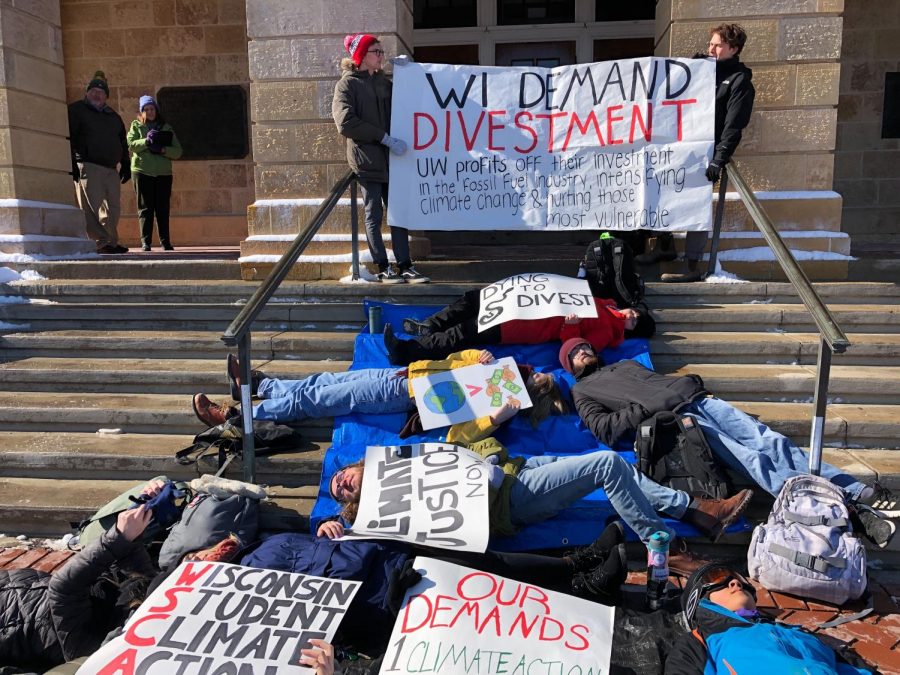Across the Country, Colleges & Universities Move to Divest
Photo by Molly Devore/The Badger Herald
University of Wisconsin students protest the institution’s fossil fuel investments.
As the issue of climate change has become increasingly salient, colleges and universities have come under increasing pressure to withdraw their investments wrapped up in different ways in the fossil fuel industry. These demands raise questions about the potential impact of fossil fuel divestment, as well as its financial and technical viability for educational institutions.
Last year, the Review reported on the College endowment’s exposure to fossil fuels (College Maintains ‘Minimal Exposure’ to Fossil Fuel Investments,” Dec 6, 2019.) Although the College has not divested fully from the fossil fuel industry, the Board of Trustees published a Resolution for Divestment and formed an Impact Investing Platform in 2014. According to Vice President for Finance and Administration Rebecca Vazquez-Skillings and Chief Investment Officer Jun Yang, the ceiling for Oberlin’s current direct exposure to fossil fuels is two percent of the endowment. That figure represents direct investments in private funds that are exposed at some level to fossil fuel investments.
The Resolution for Divestment was written in response to student divestment campaigns focused on fossil fuel consumption, private prisons, and the Israeli occupation of Palestine. The two-page document outlines a basis for divestment.
“Instances so extreme that they shock the conscience, such as genocide, ethnic cleansing, unjustified disregard of profound environmental degradation and other wide-scale acts of injustice, may call for an extraordinary response,” the document reads.
According to Oberlin’s website, updated on June 30, 2018, the College’s total endowed funds added up to $887.4 million. The College’s Asset Allocation Policy lists the targets, minimums, and maximums for asset allocation. The target breakdown is five percent cash, zero percent fixed income, 25 percent global equity, 35 percent hedge funds, five percent private credit, 22 percent private equity, and eight percent real assets. It’s not clear which, if any, of these investments are potentially or marginally tied up in fossil fuels.
Investments in global equity could be sold relatively quickly, and investments in hedge funds could likely be redeemed within a year. However, investments in private equity and real assets are the most difficult to sell. Real assets are physical assets — including real estate, natural resources, and equipment — whereas private equity accounts for companies that are not traded on a public exchange.
Private equity investment partnerships can often last for up to 10 years. In order for the College to divest from these investments, a buyer would have to take interest in buying the College’s holding, a process that could easily take between six months and a year. This would put the College in a difficult situation; even if it wanted to sell these assets, it does not want to be a forced seller, selling the assets at a loss.
Information about the College’s current exposure to fossil fuel investments is not totally clear.
“Oberlin still has minimal exposure to fossil fuel investments,” Vazquez-Skillings and Yang wrote to the Review last December. “Given the little exposure, it is difficult technically and financially to divest fully.”
However, more and more educational institutions are claiming that they have fully divested from the fossil fuel industry, citing financial risks and environmental considerations. In 2012, Unity College became the first educational institution to do so. As of 2018, 1,000 more institutions had followed suit, with combined endowments totaling almost $8 trillion.
More recently, on Feb. 6, Georgetown University joined the divestment trend when its Board of Directors decided to divest from public securities of fossil fuel companies over the next five years, with a longer-term plan to divest from private investments over the course of the next 10 years. Georgetown’s Board of Directors recognized both the environmental necessity and financial imperative of fossil fuel investment.
“Climate change, in addition to threatening our planet, is increasing the risk of investing in oil and gas companies, as we expect a more volatile range of financial outcomes,” said Michael Barry, Georgetown’s chief investment officer.
On March 4, Brown University announced that it will sell 90 percent of its investments in fossil fuel companies, with plans to liquidate the remaining portion. According to Brown University President Christina Paxson, the decision was based on the financial risk posed by fossil fuel holdings.
“The decision to halt investments in fossil fuel extraction companies reflects the view that, as the world shifts to sustainable energy sources, investments in fossil fuels carry too much long-term financial risk,” wrote Paxson in a letter to Brown’s campus community.
When student activist groups on Brown’s campus led a divestment campaign in 2013, one year prior to Oberlin’s own campaign, Paxson argued that entirely divesting from fossil fuels would have too small an economic impact on the entire fossil fuel industry to make divestment a worthwhile venture.
Still, the truth is that the fossil fuel industry is highly reliant on outside financial support. For one, fossil fuel companies are very capital-intensive, meaning they must make expensive down payments on physical infrastructure like coal plants or pipelines before they can bring in revenue. Additionally, the industry has struggled to turn a profit at all in recent years as the cost of coal production has risen and the price of oil and natural gas has fallen. Many natural gas companies have turned to Wall Street loans to avoid bankruptcy.
It’s no surprise, then, that those who profit off of fossil fuel production are deeply concerned about their increasing inability to access financial resources. Shell has referred to the divestment movement as a “material risk” to its business model; analysts at Goldman Sachs have said that divestment is a major cause of the coal industry’s decline; Peabody, the world’s largest coal company, declared bankruptcy in 2016 and listed the divestment campaign as a reason why.
College fourth-year and Students for Energy Justice member Rachael Hood sees hypocrisy in the argument that divestment has little effect on the fossil fuel industry.
“You are profiting from the fossil fuel industry and yet you’re holding values of sustainability … so I just think that that’s a very weak excuse,” Hood said. “You could make that argument about any movement for social change. … The point is that you take actions that are consistent with the values you say you hold.”
Divestment is a complex process, but events in the recent days may bolster the case; Just this week, the global price of oil plummeted to a record low of negative $38 per barrel, and has since fluctuated between negative and near-zero figures, forcing investors to consider fossil fuel investments as a potential financial risk in a challenged global economy.








